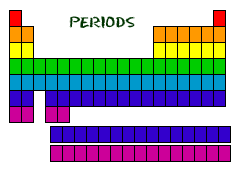Properties


Columns
-
All of the elements in a period have the same number of atomic orbitals. For example, every element in the top row (the first period) has one orbital for itselectrons. All of the elements in the second row (the second period) have two orbitals for their electrons. As you move down the table, every row adds an orbital. At this time, there is a maximum of seven electron orbitals.
Rows or Periods

-
Hydrogen (H) and helium (He) are special elements. Hydrogen can have the electron traits of two groups: one and seven. For chemists, hydrogen is sometimes missing an electron like the members of group IA, and sometimes has an extra one as in group VIIA. When you study acids and bases you will regularly work with hydrogen cations (H+). A hydride is a hydrogen anion and has an extra electron (H-).
-
Helium (He) is different from all of the other elements. It is very stable with only two electrons in its outer orbital (valence shell). Even though it only has two, it is still grouped with the noble gases that have eight electrons in their outermost orbitals. The noble gases and helium are all "happy," because their valence shell is full.
-
The periodic table also has a special name for its vertical columns. Each column is called a group. The elements in each group have the same number of electrons in the outer orbital. Those outer electrons are also called valence electrons. They are the electrons involved in chemical bonds with other elements.
-
Every element in the first column (group one) has one electron in its outer shell. Every element in the second column (group two) has two electrons in the outer shell. As you keep counting the columns, you'll know how many electrons are in the outer shell. There are exceptions to the order when you look at the transition elements, but you get the general idea. Transition elements add electrons to the second-to-last orbital.